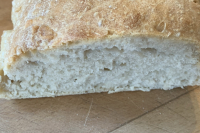Simple! And Yummy! Minimum mess and ready in 35 minutes with only 5 minutes work! This is a cheese-and-onion-y delicious side dish from the oven or even a quick dinner for two. Here’s the recipe:
Baking Bread: New Flour Type
I got hands on a (to me) completely new type of bread flour. It‘s the German type „812“ and funny enough, in the US it‘s called just „bread flour“ 🙂 . It‘s surprisingly difficult to find in supermarkets here, although it seems to be pretty common for professional bakers.
What I found out is that you actually need a little less water than when working with the standard type 55 (all-purpose flour) and that it likes to ferment a little longer. But I may be wrong since I‘m just puzzling together the results of my first try.
Anyway, I got very good bread from it just using my spelt flour bread recipe and reducing the amount of water little bit.
Spelt Flour Bread
Today I’ve got something completely new, at least for my standards. I made bread from spelt flour for the first time – and I was surprised about how much I actually like it. Now, spelt has a little bit of a reputation of being in the eco- or treehugger corner (at least here where I live) but at the end of the days it’s just plain normal flour to work with.
Easy Oven Flatbread
 … with olive oil, salt and rosemary. Easy and convenient. Oh, and also yummy.
… with olive oil, salt and rosemary. Easy and convenient. Oh, and also yummy.
You’ll need:
500 g all-purpose flour
1 pkg. active dry yeast
1 tsp. salt
1/2 tsp. sugar
2 tbsp. olive oil
300 ml lukewarm water
Topping: Olive oil, coarse salt, rosemary
Basic Pizza Dough Recipe
Notes on Flour

Stolen from here

(Updated) Stolen from here
Hey! In reaction to my recent post on yeast I’ve been asked “what about flour”? Well, I’m not a baker, I’m not into cake, cookies and pastry – just baking bread from time to time.
So here’s my (very condensed and one-sided) information on flour types that I have learned over the last couple of years, with special focus on the differences / translations between american and german. Good sources for more information are cheatsheet.com and weekendbakery.com.
(Concerning that Image: I’ve actually never heard of “Flour Type 812” here in Germany…)
Notes on Baker’s Yeast
 I like baking my own bread from time to time. Recently, I came across some useful information on baker’s yeast that I want to share here:
I like baking my own bread from time to time. Recently, I came across some useful information on baker’s yeast that I want to share here:
As you all know, there are two types of yeast being sold in supermarkets – fresh yeast and dry yeast. They’re to be handled a little different each since they come in different forms, but they’re both the same organism (“Saccharomyces cerevisiae” – which derives from its origin from brewing beer). They also both do the same thing: They give your dough fluffiness, airiness and volume by natural fermentation.
– Fresh Yeast comes in the form of little cubes, always weighing 42g
– Dry Yeast comes as a powdery substance in little packages, always weighing 7g
Hauke, Part III and How to (Sourdough Starter)
After one day of rest, it’s day 4 of the sourdough test now. It has a distinct sourly smell, rather fresh and not pungent or moldy and it bubbles. I’ll feed it one last time today and then try it out for baking bread. After all, I can sum up the process as follows:
All Categories:
- Common (77)
- DIY Projects (161)
- Fire & BBQ (50)
- Garden & Growing (49)
- Knife making (40)
- Recipes & Kitchen (247)
All Tags:
Chickens & Pets · How Tos · Lada Niva · Manly Hints · Nice to Know · Plans & Info · Prepping · Reading · Reviews & Products · Sticky · Travel
I’m (somewhat) social, too!


























































































